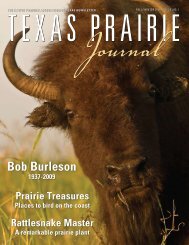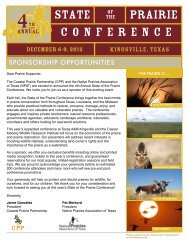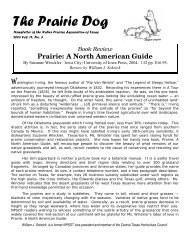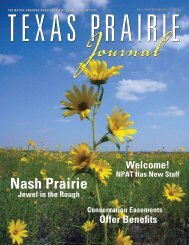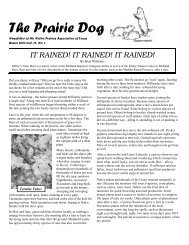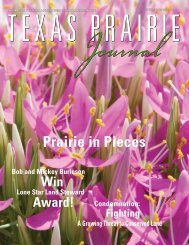2007 Fall/Winter issue - Native Prairies Association of Texas
2007 Fall/Winter issue - Native Prairies Association of Texas
2007 Fall/Winter issue - Native Prairies Association of Texas
You also want an ePaper? Increase the reach of your titles
YUMPU automatically turns print PDFs into web optimized ePapers that Google loves.
Saving <strong>Texas</strong> <strong>Prairies</strong><br />
The Mission <strong>of</strong> the <strong>Native</strong> <strong>Prairies</strong> <strong>Association</strong> <strong>of</strong> <strong>Texas</strong> (NPAT)<br />
By Jason Spangler<br />
<strong>Texas</strong> is a prairie state:<br />
from the tallgrass prairies <strong>of</strong><br />
the Blackland <strong>Prairies</strong>, Coastal<br />
<strong>Prairies</strong>, and Cross Timbers and <strong>Prairies</strong>,<br />
the native savannas <strong>of</strong> the Hill Country/<br />
Edwards Plateau, the mixed grass prairies<br />
<strong>of</strong> the Rolling Plains, the short-grass<br />
prairies <strong>of</strong> the High Plains, and the<br />
desert grasslands <strong>of</strong> the Trans-Pecos, the<br />
diversity and beauty <strong>of</strong> <strong>Texas</strong>’ prairies are<br />
incredible and breathtaking.<br />
As part <strong>of</strong> the strategic planning for<br />
the organization, the board <strong>of</strong> directors<br />
has determined that NPAT’s mission to<br />
save <strong>Texas</strong>’ prairies requires resources<br />
beyond the organization’s current means.<br />
Therefore the board has undertaken<br />
a fundraising effort to raise the funds<br />
required to execute our mission to save<br />
<strong>Texas</strong>’ prairies.<br />
NPAT needs your help to accomplish our<br />
shared goals <strong>of</strong> native prairie conservation,<br />
restoration, and appreciation. We must<br />
raise funds from private donors and<br />
foundations to carry out our mission,<br />
hire staff, monitor prairie conservation<br />
easements, manage owned native prairies,<br />
purchase prairie conservation easements<br />
and prairie land, and perform outreach to<br />
the public.<br />
Please consider NPAT in your charitable<br />
giving and estate planning. You can help<br />
save <strong>Texas</strong> prairies in many ways, such<br />
as volunteering your time, supporting our<br />
programs, donating conservation easements<br />
on native prairie land, and giving towards<br />
NPAT programs or an endowment to<br />
support staff and programs. If you know<br />
<strong>of</strong> foundations or individuals who may be<br />
willing to help save <strong>Texas</strong> prairies, please<br />
talk with them about these natural treasures<br />
<strong>of</strong> <strong>Texas</strong> and ask for their help.<br />
We can make a difference if we work<br />
together to save <strong>Texas</strong>’ incredible prairies.<br />
We hope you will join us.<br />
The Need to Save <strong>Texas</strong>’ <strong>Prairies</strong><br />
<strong>Texas</strong>’ prairies need our help now, the<br />
tallgrass prairies most <strong>of</strong> all.<br />
Conservationists rank most <strong>of</strong> <strong>Texas</strong>’<br />
tallgrass prairie plant communities as<br />
critically imperiled or imperiled, the<br />
highest conservation rankings that exist.<br />
WWF ranks <strong>Texas</strong> Blackland Prairie as<br />
Photo Courtesy <strong>of</strong> Jaosn Spangler<br />
critically endangered. To save these rich<br />
native plant communities, we must protect<br />
prairie remnants and restore prairie where<br />
it once existed.<br />
It is estimated that less than 1% <strong>of</strong><br />
<strong>Texas</strong>’ beautiful tallgrass prairies remain,<br />
and losses to plowing and development<br />
continue. Most <strong>of</strong> the fastest growing areas<br />
<strong>of</strong> the state fall within the tallgrass prairie<br />
regions <strong>of</strong> <strong>Texas</strong>. We must act now to save<br />
these special places for current and future<br />
generations.<br />
To preserve <strong>Texas</strong> history and<br />
experience what the early Texans saw,<br />
we must save <strong>Texas</strong> prairie. To provide<br />
wildlife habitat for prairie species like<br />
grassland birds (the most declining group<br />
<strong>of</strong> birds in North America) we must save<br />
and restore our prairies. To continue <strong>Texas</strong><br />
hunting traditions, to stop the decline <strong>of</strong><br />
upland game bird populations, including<br />
bobwhite quail we must save and restore<br />
prairie.<br />
Recent studies have found that tallgrass<br />
prairie plantings are the best source <strong>of</strong><br />
bi<strong>of</strong>uels while simultaneously providing<br />
prairie wildlife habitat and sequestrating<br />
carbon in the ground, thus helping us<br />
reverse global warming. A recent study<br />
found that planting tallgrass prairie on<br />
the country’s marginal farmland that is<br />
already not productive could provide most<br />
<strong>of</strong> our fuel needs while preserving the best<br />
farmland for food production. To promote<br />
prairie bi<strong>of</strong>uel plantings in <strong>Texas</strong> and ensure<br />
a supply <strong>of</strong> locally adapted native prairie<br />
seed, we must save <strong>Texas</strong> prairie.<br />
Public Attention<br />
to <strong>Native</strong> <strong>Prairies</strong><br />
Increasing<br />
In addition to increased<br />
public attention toward<br />
prairie bi<strong>of</strong>uel, water quality<br />
and carbon sequestration<br />
benefits, wildlife habitat,<br />
and <strong>Texas</strong> history, there is<br />
growing concern for saving<br />
our natural treasures in the<br />
face <strong>of</strong> increasing population<br />
growth. As one <strong>of</strong> our rare<br />
and beautiful natural wonders,<br />
native prairies deserve a<br />
special focus when preserving<br />
<strong>Texas</strong>’ natural history.<br />
Landscaping with native<br />
prairie plants can also be a large part <strong>of</strong> the<br />
solution to water availability. By planting<br />
native prairie plants instead traditional<br />
lawns, we can increase water available<br />
for drinking and other uses, by reducing<br />
landscape and lawn water usage; increase<br />
water quality by removing a major source<br />
<strong>of</strong> pollution from pesticides, herbicides,<br />
and fertilizers used in wasteful landscapes;<br />
decrease air pollution by re ducing the<br />
use <strong>of</strong> dirty gas lawn mowers and leaf<br />
blowers; and help solve global warming<br />
by saving massive amounts <strong>of</strong> energy and<br />
reducing the resulting pollution that water<br />
treatment requires.<br />
How We Can Save <strong>Texas</strong> <strong>Prairies</strong><br />
Several years ago the board undertook<br />
strategic planning to determine NPAT’s<br />
needs in order to more effectively carry out<br />
its mission to save <strong>Texas</strong> prairies, and how<br />
those needs could be met.<br />
The highest priority in the strategic plan<br />
is the hiring <strong>of</strong> staff, since the need for<br />
prairie conservation requires much more<br />
time than a volunteer board and other<br />
volunteers can provide.<br />
During the board’s current fundraising<br />
efforts, we determined that NPAT needs an<br />
Executive Director to execute NPAT’s goal<br />
to save <strong>Texas</strong> prairies and a Development<br />
Director to work with donors and foundations<br />
to raise the funds needed to protect prairies<br />
and conduct NPAT’s programs.<br />
The Executive Director and Develop-<br />
8 <strong>Native</strong> <strong>Prairies</strong> <strong>Association</strong> <strong>of</strong> <strong>Texas</strong> TEXAS PRAIRIE Journal



